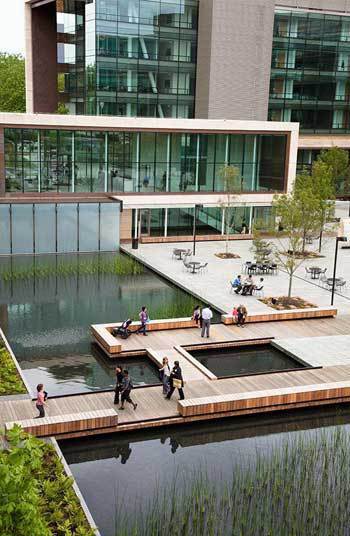
ASLA 2014 Professional Award of Excellence. Bill & Melinda Gates Foundation Campus, Seattle, Washington. Gustafson Guthrie Nichol / Timothy Hursley
Landscape architecture services in the U.S. are currently valued at around $2.3 billion per year, according to a new report from the National Endowment for the Arts (NEA). The latest data, which covers up to 2012, shows that landscape architecture services account for 14 percent of total architectural services, which are estimated to be valued at $16 billion. In 2012, an estimated 21,000 landscape architects were employed, earning about $1.8 billion.
The report shows architecture and design industries as a whole were hard hit by the recession from 2007 to 2009. From 1998-2008, architectural and design services -- which also includes a range of industrial, interior, and graphic design services -- accounted for 0.25 to 0.27 of the U.S. gross domestic product (GDP). In 2009, that number dropped to 0.22 percent of GDP, "a current-dollar decline of $8.7 billion from value added in 2008." And the decline just continued through the recessions to 2012, when the value added by architectural and design services hit a "15-year low of 0.19 percent." As NEA has not yet presented any data from 2013 and 2014, it's unclear whether architectural and design industries have come back to pre-recession levels. But numbers from the American Society of Landscape Architects (ASLA) shows a dramatic uptick in business for landscape architects from 2008.
The NEA's report doesn't attempt to quantify the broader economic impact of landscape architecture. For example, it has been demonstrated that designed urban plazas and green spaces generate significant economic benefits: they raise nearby property values, which in turn leads to more tax revenue for governments, attract tourists, clean the air, and store stormwater. According to a report from the Trust for Public Land's Center for City Park Excellence, Central Park in New York City is estimated to create 1,000 jobs and contribute $80 million in direct economic benefits as well as an additional $665 million in tax revenues due to the fact that it raises the value of nearby property by $17 billion. There's also the monetary value of ecosystem services, the benefits of cleaner air and managed stormwater for Manhattan. The question remains: how can the broader economic impacts of landscape architecture, and really design in all its forms, be better measured in national data?
The only good news in the report is in 2012 the U.S. exported nearly $2.4 billion in architectural services, creating a trade surplus in this area of $1.5 billion. This surplus has only been increasing over the past few years, as more American landscape architects take on ambitious projects in the Middle East and Asia.
Jason Schupbach, NEA Director of Design, told us: "The headline to us from this data is the growing trade surplus in landscape architecture services. It says to us that American design is in demand across the world, and that demand is growing."
